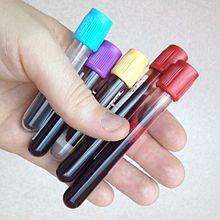Anemia--When There's Not Enough Blood
- posted: Oct. 15, 2017
 Causes of Anemia in Dogs and Cats
Causes of Anemia in Dogs and Cats
Anemia, a decreased number of red blood cells in the body, is a fairly common problem in dogs and cats. Why do we care if our pets are anemic? Lack of red blood cells can lead to decreased oxygen carrying capacity in animals which causes symptoms of lethargy/decreased activity, pale gums, panting or difficulty breathing, decreased appetite and sometimes collapse. If enough blood cells are lost, pets may even die from severe anemia.
There are three main causes of anemia in pets: blood loss, red blood cell destruction and lack of red blood cell production.
Blood loss is fairly self-explanatory. The pet is losing blood. This could be acute or sudden as with an injury, for instance, trauma causing bleeding either from a lacerated blood vessel or injury to internal organs, sudden blood loss from a tumor such as hemangiosarcoma on the spleen, or exposure to rat poison causing internal bleeding. Or blood loss could be chronic such as from an ulcer in the stomach, chronic blood loss from the urinary tract, or from a severe intestinal parasite or flea infestation.
Destruction of red blood cells can occur for several reasons. Immune mediated hemolytic anemia is the most common cause of red cell destruction—something triggers a defect in the patient’s immune system that causes it to break down its own red blood cells. Destruction may also occur with certain bacterial, viral and protozoal infections that target red blood cells, by certain toxins such as acetaminophen toxicity in cats, or certain rare, inherited defects affecting red blood cell life span.
Lack of production of red blood cells can occur if there is disease in the bone marrow such as cancer or lack of production of hormones that stimulate red blood cell production which may occur in patients with chronic kidney disease or other chronic illnesses.
Patients are most often diagnosed with anemia based on physical exam findings of pale gums or signs of active blood loss if present. Blood tests often confirm the severity and type of anemia. Samples of tissue from the bone marrow may be needed in some cases.
Treatment varies based on the underlying cause, but severe cases of anemia where massive acute blood loss is evident or when the blood count is below 12-15% often require a blood transfusion.
If your pet exhibits any of the symptoms listed, especially pale or white gums or extreme lethargy, have him or her seen by your veterinarian immediately. While in most cases pets can be treated, anemia is very serious and some forms may even be deadly.
This blog brought to you by the Patton Veterinary Hospital serving Red Lion, York and the surrounding communities.
Location
Patton Veterinary Hospital
425 E Broadway
Red Lion, PA 17356
